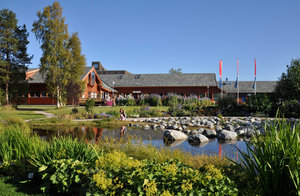Nibio Svanhovd Research Station

Address
NIBIO Svanhovd23 Svanhovd,
NO-9925 Svanvik
Norway
Station manager
Snorre HagenStation Features
Opening year: 1934 Status: OpenFacilities
Station name and owner
The Nibio Svanhovd Research Station belongs to the Norwegian Institute for Agricultural and Environmental Research (Bioforsk).
Location
Nibio Svanhovd is located in the Pasvik area in NE Norway (69°27’ N, 30°03’ E), approximately 40 km south of the fjords of the Barents Sea, 400 km north of the Arctic Circle, and in close vicinity to Russia and Finland. Nibio Svanhovd is situated in Svanvik, a small village in the Pasvik Valley. It is located at the western shore of the Pasvik River that originates from the huge Lake Inari in Finland and flows northwards into the Barents Sea and defines the border between Norway and Russia.
Climate data
Grey colours are WMO Climate Normals including maximum and minimum values. Blue colours are individual years.
Climate data for the stations where extracted via Copernicus Climate Data Store, from the global gridded reanalysis product:
ERA5 monthly averaged data on single levels from 1940 to present.
Description and source code: Roemer J.K. 2023. https://doi.org/10.5281/zenodo.10214922
Data Source: Hersbach et al. 2023. Copernicus Climate Change Service (C3S) Climate Data Store (CDS), https://doi.org/10.24381/cds.f17050d7
Biodiversity and natural environment
The surroundings in the Pasvik Valley are part of the western distribution limit of the Russian taiga and the fauna and flora has a strong eastern influence, with many species not found in other areas of Europe, e.g. interesting aquatic flora. The area includes old-growth pine forest, wetlands, lakes, rivers, mountain birch forest, tundra, seashore, and fjords. Most groups of organisms in the area are poorly studied with many still unknown species in certain taxa. The area is also found to be the northernmost distribution of several species and the Pasvik River has a very high biological diversity compared to other rivers in Norway. The area is exposed to several invading species.
History and facilities
Svanhovd was established in 1934 as a governmental demonstration farm to provide expertise and aid to the settlers of the Pasvik Valley. In the early 1990s, a change of activity towards environmental research was motivated in particular due to large emissions from the metal smelters in the Russian city Nikel (9 km away from Svanhovd). 2001, a visitor centre for the Øvre Pasvik National Park was established and, in 2006, Svanhovd Environmental Centre became a part of the Norwegian Institute for Agricultural and Environmental Research. The laboratory at Bioforsk Svanhovd has facilities for microbiological, chemical-physical, and DNA-analysis. It is accredited for DNA analyses of brown bears. Bioforsk Svanhovd has a conference centre with accommodation for 50 persons (in single and double rooms, with private bathrooms). Guests are free to use Svanhovds fireplace, TV lounge, sauna, and laundry room. The conference centre offers an auditorium for 80 persons, and smaller meeting rooms for 5 to 30 persons. Additional accommodation can be arranged in Svanvik (walking distance) and at hotels in Kirkenes (45 minutes by car).
General research and databases
The region offers ‘round-the-corner ecological laboratories’ for several important research areas: Pristine nature in subarctic ecosystems, changes in land use (farming and abandoned land), climatic and environmental gradients, etc. Bioforsk Svanhovd works with issues related to natural resources, protected areas, biological diversity, and environmental research in the Barents Region. Some work on agricultural issues is also carried out. Each year, surveys within the national brown-bear monitoring programme in Norway, Finland, Sweden, and Russia is carried out.
Link to data: https://dataportal.eu-interact.org/stations
Station Monitoring
Human dimension
The Pasvik Valley offers nature tourism, fishing, bird-watching, hunting, forestry, northern agriculture, reindeer husbandry, mining, and research. Kirkenes (c. 3400 inhabitants), that is located 40 km NW of Svanhovd, was established in late nineteenth century as a port town for the mining industry at Bjørnevatn a few km away and for forestry. The area has been inhabited by Sami people for several centuries.
Access
Svanhovd is an excellent meeting point for researchers and visitors from all over the world, situated in NE Norway in close vicinity to Russia, Finland, and Sweden, and with the facilities offered by Svanhovd Conference Centre. The Botanical Garden at Svanhovd demonstrates the diversity of plants and trees in the Pasvik Valley. It is easy to come to Svanhovd, with daily flights from Oslo Gardermoen Airport to Kirkenes Airport (Høybuktmoen), with about 2 hours flight time (SAS and Norwegian), and then 45 minutes (40 km) by car to Svanhovd (Road 885). Taxi or rental cars are available at Kirkenes Airport.

